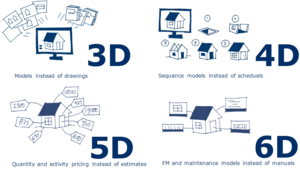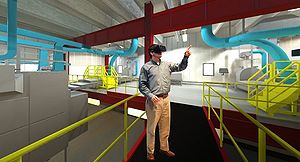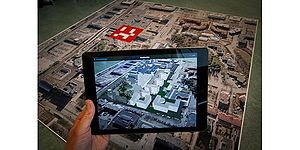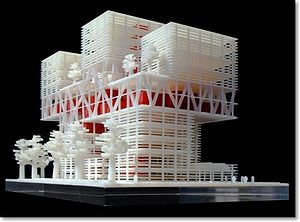VDC as a project management tool on construction projects
Developed by Mie Louise Elsborg Drejer
Virtual Design and Construction (VDC) is a project management tool which focuses on the design phase in a construction process. In short it is used to reduce changes in orders because it is possible to satisfy the stakeholders even before the construction phase begins and this means an overall less complicated and more flawless process.
In traditional construction, the design and planning phase consists of several different 2D drawings which are used to share information and to expand the design afterwards by analyzing and making specifications. To optimize this decision making process the term Building Information Model (BIM) is introduced. A model used to store information of physical features and functionality of the facility as data that can be assigned by the different partners in the project work. The BIM’s are an essential part of the mentioned project management tool Virtual Design in Construction where a digital 3D model is created enabling design and construction virtually. VDC operates with dimensions going from 3D to 6D.
The different dimensions add the time schedule along material's quantity, pricing and maintenance information to the 3D model. An upcoming feature of VDC is virtual reality, which gives the coming user of the facility the opportunity to experience going trough the facility using 3D glasses. The virtual reality avoids bad design decision in the spacing of the facility.
The VDC will optimize information sharing to a fast and precise process between the parties in the project. Different alternatives in the facility design process can easily be evaluated to optimize the product. Last, the client has a much better starting point in experiencing the facility before the building process has even begun, resulting in less surprises leading to less changes. This is defined as change orders.
However good this sounds the implementation of VDC must be considered carefully, a lot of education is needed and especially the craftsmen on the construction site needs adapting. This article will adopt the VDC tool to construction projects by going through different sections and it will discuss the advantages and disadvantages when implementing the tool in the early construction planning phase.
Contents |
Overview
Background
Previously in traditional construction processes, you handled the design and planning phase of the construction by creating 2D drawings which is subsequently expanded by making an analysis and creating specifications to the drawings. Because the decision making, in traditional construction methods, sometimes ended up unnecessarily long the term Building Information Model (BIM) was created. A BIM is defined as \emph{"a digital representation of physical and functional characteristics of a facility"} \scite{nationalbimstandard}.
The BIM model stores all the information about the building which is both its physical and functional features. All this information can be used to optimize the decision making, and the overall goal is to have information stored for every single component in the construction. BIM is widely used in the construction sector and a big part of the digital design process which is introduced by the new tool called Virtual Design and Construction (VDC).
The tool VDC can be used to achieve many benefits on large and smaller construction projects, and are considered as a fundamental project management tool to effectively reduce change in orders in construction projects. Some of the benefits are listed below:
- When using VDC it is possible to have high precision in the planning of orders which leads to higher safety on the construction site.
- VDC allows the user to save time and therefore money on construction projects.
- VDC allows the user to calculate pricing and quantities directly instead of giving estimates, which also means a new price easily can be obtained in case of changes.
- The tool gives basis for decision making because the client is often interested in knowing the immediate cost and the cost over ten years.
Application
In order to use VDC as a tool a digital model is created which shows design and construction virtually. This means that you can change different parts of the project multiple times before the actual construction process starts, which is different from the traditionel methods were you started the contruction process based on 2D drawings. Figure 3 shows how the VDC process operates with dimensions going from 3D to 6D.
The process begins with creating a 3D model which can lead to fewer errors and inconsistencies compared to the 2D drawings in traditional methods. Then you proceed to the fourth dimension where you add the time schedule to the 3D model. This time schedule are considering different sequence of the models, which gives a better understanding of the different phases. [1].
The fifth dimension is used to add cost on the previous model (the 4D model), which means that a budget can be proposed to potential clients. In the 6D model we add information about the operation and facility management, to the 5D model. This dimension is a full documentation of the product, the client is able to see an overview of the overall costs of the construction and following maintenance.
Utilization of Virtual Design and Construction
Virrtual reality
Virtual reality (VR) is a relatively new tool and the technology concept need much development, nevertheless it has become a more and more often used tool in the Danish building sector and the rest of the world. Because of virtual reality the client is able to experience the project virtually through 3D glasses and similar tools before the construction is started.
Virtual reality can be used to improve designs, decision making and the overall building process. Companies can choose to introduce a building project with virtual reality, which means that multiple users can experience the product through use of projection technology and 3D glasses. For example, when construction a care center the VR can be a nice feature. Doctors and nurses can be invited to participate in different trials, where they are able to virtually walk around in the new building. Another example could be an university where students need a new laboratory, and here the VR can help placing different necessary equipment, by testing and visualising.
Because of this we can optimize the design and facility management in the construction. Overall this new technology safes a lot of time and money because the client is satisfied with their new building before the actual construction phase begins. Figure 2 and figure 3 shows respectively how it would look for a person experiencing VR and then how tablets could be used to visualise future building projects.
3D printing
Besides virtual reality the construction sector uses 3D printing as a method to reduce change orders and optimize decision making in the construction process. 3D printing is very useful in the designing phase because when the client can observe a physical model new possibilities and ideas arises and communication mistakes between parties can be avoided.
Furthermore 3D printed models can be used for planning and allocation on a construction site at any size. This means that if you place the model on a precise scaled map you can plan the placement of cranes and transportation routes. Therefore it is possible to improve effectiveness because everything is more thoroughly planned.
Both mentioned tools ensures that the client has the opportunity to change his mind about the design and the different parts of the construction, before the construction process begins, and therefore reduce change orders.
Integration on the construction site
In theory the above mentioned tools are good and maybe even a perfect way to make the construction process flawless, but you need to think about how they work in practice. Though VR and 3D printing can be used to reduce change orders, it has to be implemented proberly in both the design phase, the building process and on the construction site before i makes a difference.
A possible solution could be to provide site workers with Tablets which contained 3D models and additional information of the construction, this way you make sure that all information i easily accessible for everyone involved in the project. By doing it this ways it is possible to lose some of the unnecessary 2D drawing which often take a lot of good overview and desk place.
However construction managers and workers can be a bit skeptical about all the talk about using VDC as a tool in construction management. New methods means new routines in the construction sector, and all parties of the constructions phases needs to be adaptable. So for this to work there needs to be something more, which is adaptable leaders who lead the way in the process of making VDC a fixed part of a construction process.
Discussion
First step in managing any kind of construction project is to define what is wanted. This can be done with a project mission, which is an overall strategic intent of the project. You can say that a good consulting engineer begins a project by defining what the client want, which is not easy because all stakeholders involved in the project has to be satisfied in order to deliver a successful result [2]. But no matter how well defined the project is changes will occur doing the execution of the construction, which do not depend on the size of the project. Two typically change orders in the building process i listed below:
- Stakeholders who changes their mind because they have direct benefit or loss as a result of the project.
- Change orders can appear when stakeholders have economic challenges, due to delay or mis-consigned delivery of building elements.
VDC is a tool that allows you to avoid some of these typical change orders, and overall will VDC, in time, be a great contribution to the traditional methods in the construction process. This is because it is a tool which can make the whole construction process more flawless, and it can help satisfying the different stakeholders even before you begin the construction phase. At the moment the technology for this method is relativily new and not a normal tool to use in the building sector. However the technology is developing rapidly and hopefully over time it will be fully implemented and also be a great help for managing construction processes.
Below are mentioned and discussed some of the advantages and disadvantages by the use of VDC as a tool on construction processes. But note that the advantages and disadvantages also depends on the whether it is seen from the clients and contractors point of view. Further more we take a short look on VDC as a collaboration tool.
Advantages and Disadvantages
The biggest advantages of VDC is that this tool makes the construction process more flawless and it can help reduce change orders doing the process. This means less time spend and therefore less money spend on the projects. All this is possible because the client is able to see different design alternatives early and therefore make a more confident decision about the bulding and the facilities within.
One of the disadvantages is that it places greater demands on the consulting engineers in the construction sector. All participants in the project needs to do an agreement on doing the necessary education and work to fully experience this tools potential. This means that not only the designers and the client, but also the construction manager and the site workers should be able to see the potential in the new way of designing and planning a construction.
This leads to the major disadvantages of VDC, which is implementation. The decision to use the tool may come from the board, but it is necessary to incorporate every part of your firm. Furthermore it is necessary that the parties of the project is involved in the process early, which requires a lot of participation effort and change of habits. This also means better training of employees and different kind of courses to learn how the new technology works and how to use the provided tools optimally. It needs to be done properly otherwise you should not invest is such a complicated tool.
Collaboration with other tools
VDC is also an excellent tool to use in a cooperative context. Some of the most common tools used, in order to reduce change orders in construction, is listed below:
- Partnering has focus on the collaboration between the different parties in a construction process. Graham M. Winch [2] states following among other things about partnering \textit{formal arrangements between at least two members of the project coalition to work together on a programme of projects for a defined period}. This tool covers a variation of different procedures with common features. Most important is a trustful collaboration between parties in the construction process.
- Value Management is divided into two, the external set of values which defines the client's value to the product and process. And this defines the final value of the building from the client's point of view. The second is the internal value which is the values of the project team. It is defined by the value-based behavior in the team, because this way the supply-chain will work together with the common goal to create the best solution for the client.
- Lean Construction in very short has its roots in the Lean Production, which in turn is based on the Toyota Production System. The Toyota Production System has been in development since 1950, and was and immediate response to the Flow Based Production System developed by Henry Ford based on standardized products [3]. Lean production is a business philosophy based on the hope of simplifying and streamlining the production process.
All tools can be used, therefore it should be decided by the client and the contractor which ones is best for the project. This is depending on which change orders the partners want to avoid or reduce. It is not possible to implement every single one because it leads to more confusion for the parties involved.
The overall best tool to use in cooperation with VDC is Lean Construction. This is because you can not control the activities if the knowledge sharing and communication is leaking in the transition phase. Leaking communication between to phases will certainly result in mistakes, which results in change orders later on in the construction process.
Conclusion
There are more than just one way to reduce unwanted change orders in a construction project. The one used in this article is called virtual design and construction (VDC), and is a relatively new tool in the building sector which can be used to add more value to the design phase of a project. By using this tool the client has the possibilities to see the design and experience the building before the construction even begins. This means minimizing the risk of the client, or other stakeholders, changing smaller or maybe even major things on the design in the middle of the construction process.
Further more this tool can be used to improve the communication between the consulting engineer and all other parts of the project meaning a more optimized construction process, because it is possible to reducing waste and a improved time schedule. The biggest problem, which is also major for the future of using VDC as a management tools on construction projects, is the implementation. The working process needs to go through huge changes to achieve full potential. It takes time and effort to make VDC a standard option in the industry.
Finally it can be concluded that you should not implement every tool in the toolbox on every construction project, this would result in more confusion and more change orders. Instead you should take a look at the specific project and decide what is really needed to optimize the process and how you best satisfies the stakeholders.
References
- ↑ MT Højgaard, From 2D to 6D with Virtual Design and Construction, 2015
- ↑ 2.0 2.1 Graham M. Winch, Managing Construction Projects - An Information Processing Approach, United Kingdom, 2010
- ↑ Rolf Simonsen, Lean Construction and Last Planner System, Værdibyg - Værdiskabende byggeprocess, 2014
Annotated bibliography
- 1. Winch, G. M., 2010, Managing Construction projects, second edition
- Summary: This book proposes new ways of thinking about project management in construction processes.
- 2. Attrup, M. L.; Olsson, J. R., 2008, Power I Projekter Og Portefølje.
- Summary: This is a book that provides guidance on how to create succesful projects for both experienced managers as well as beginners dealing with project management.
- 3. Heizer J. and Render B., 2014, Operations Management - Sustainability and Supply Chain Management, eleventh edition
- Summary: Part three work with Managing Operations, and has a good description of the concept of lean production and the Toyota Production System.
- 4. Bips, Digital constructions 2006. “3D Working Method 2006”
- Summary:The 3D working method is part of a series of publications, designed to specify a common coherent working method for all parties of construction projects so that 3D models can be created, exchanged and re-used throughout the entire project life-cycle.
- 5. Andersson, N. 2016, “BIM-based Management of Construction presentation”, June 2016, DTU
- Summary: A lecture presentation from the course "Planning and management in construction" at DTU. The presentation introduces BIM as a planning and management platform.
- 6. Bonke, S. 2016, “Alliancing, Collaborative Project Governance, Trust and Partnering in Management of Construction”, June 2016, DTU
- Summary: A lecture presentation from the course "Planning and management in construction" at DTU. The presentation introduces partnering as a tool to reduce change orders and trust based sharing of knowlegde.
- 7. Woksepp S., 2007, Virtual Reality in Construction - Tools, Methods and Processes
- Summary: It is an doctoral thesis which describes how the construction process can benefit and learn from using Virtual Design and Conztruction. Furthermore it describes the use of 3D printing and Virtual Reality.
- 8. Gaudiosi, J., http://fortune.com/2015/08/25/mccarthy-construction-vr/, August 2015
- Summary: This article is an example of an American Building Companie who is starting to use Virtual Reality: "Virtual reality lets McCarthy Building Companies show clients a finished building before a single brick is laid."



